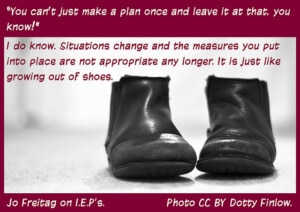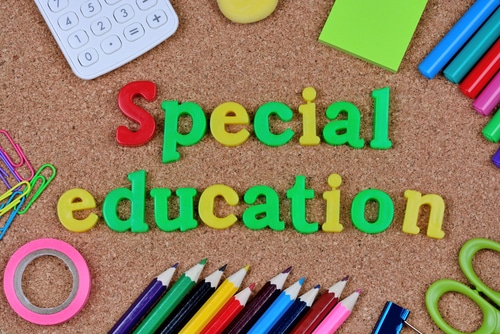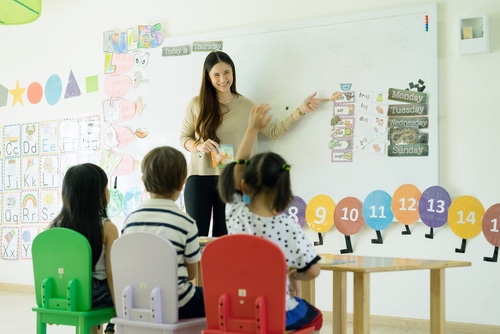An IEP meeting is an annual meeting to create or revise an IEP, or Individualized Education Program. An IEP is a legally-binding document that lays out what a student with a disability needs to be successful in the classroom. It is different for every kid depending on what they need! Some kids need extra testing time, others need to be seated closer to the board, and so on. IEP meetings are good because they help the child get what they need to learn. Yay!
Who is on the IEP Team?
Basically, everyone who works with the child (including parents or caregivers) is on the IEP team. Usually, this includes the general educator and special educator. If the child works with a speech therapist, occupational therapist, physical therapist, paraprofessional, or other professionals, they will be there too. The school psychologist usually attends as sort of a “moderator.” The parents or other family members that take care of the child will be there, and in some cases when it is developmentally appropriate, the child himself attends. The parents are also allowed to bring advocates or other people for support. There may also be a translator present at the meeting if the family does not speak English as their native language (the school, not the parents, provide the translator).
Why do we have the IEP Meeting?
The IEP meeting is the formal opportunity for everyone to get together and talk about the child’s progress over the last year and set goals for the coming year. It’s a chance for everyone to get on the same page and to make sure the child is getting what he or she needs to learn.
Photo by Mary St. George
IEP meetings are also required by law (as part of the Individuals with Disabilities Education Act, or IDEA). There are lots of legal requirements for IEP meetings. Most of them boil down to the importance of the family’s rights and making sure the school bureaucracy doesn’t “push them around” when it comes to setting goals, scheduling the meeting time, having a translator present, and so forth.
What Happens at the IEP Meeting?
Ideally, at an IEP meeting, everyone has an equal role. The family may even have more of a voice, since it’s their child! Unfortunately, parents aren’t always vocal, so it’s on us as teachers to help families feel welcome and comfortable speaking up. Try sitting in a circle instead of all the therapists and teachers on one side and the parents on the other. Sitting in a circle sets the stage for teamwork and communication! Meetings should also begin with everyone going around and introducing themselves and their role.
The meeting then covers the child’s progress towards meeting last year’s goals and a discussion of new goals. This should be individualized for the child and be based on both observations of the child’s progress and team discussion! Some schools use pre-filled forms, which kind of takes the “individualized” out of “individualized education plan.”
During the meeting, the paperwork asks for lots of statements about how the child is “impacted by their disability.” In practice, that can come off pretty negative! Make sure that your team focuses on the whole child, not just his or her challenges. It means a lot to families, and to the child himself, that you see the child’s strengths and interests as much as his challenges. Mention the good things as much (or more!) in your meeting as you do the challenges.
The team will also determine what “accommodations” and “modifications” the child needs. An accommodation is something that helps the child learn the same material as his or her classmates. For instance, a change in delivery (e.g., book on tape instead of written material) would be an accommodation. So would a change in seating (e.g., sitting closer to the board) or using special equipment (e.g., a wheelchair). A modification is a change in what material the child is learning or in what qualifies as mastery of the material. For instance, a child might be working on addition rather than multiplication tables. Or while other students need to get 8/10 words correct to pass a spelling test, a student may have a modified goal of 4/10 words correct to pass. It’s important to remember that accommodations and modifications are not “special treatment,” it’s what a student needs. It’s just like a student wearing eyeglasses to see better! It’s not special treatment, it’s a need.
IEP meetings can be stressful for teachers and for families. To be team players, remember you’re all there to help the child!





